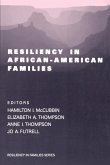- Broschiertes Buch
- Merkliste
- Auf die Merkliste
- Bewerten Bewerten
- Teilen
- Produkt teilen
- Produkterinnerung
- Produkterinnerung
This book provides students with a systematic sociological study of contemporary life for families of African descent living in the United States. Because it deals with issues facing African American families, it covers ground that is often considered, such as marriage and fertility rates, non-marital births, age at first birth, etc., but the authors also deal with several issues slighted or ignored in texts about African American family life, including disproportionately high rates of incarceration, family violence, and chronic diseases such as HIV/AIDS. Also departing from previous books,…mehr
Andere Kunden interessierten sich auch für
![Resiliency in African-American Families Resiliency in African-American Families]() Hamilton I. McCubbin / Elizabeth A. Thompson / Anne I. Thompson / Julie E. Fromer (eds.)Resiliency in African-American Families135,99 €
Hamilton I. McCubbin / Elizabeth A. Thompson / Anne I. Thompson / Julie E. Fromer (eds.)Resiliency in African-American Families135,99 €![The New African American Urban History The New African American Urban History]() Kenneth W. Goings / Raymond A. Mohl (eds.)The New African American Urban History158,99 €
Kenneth W. Goings / Raymond A. Mohl (eds.)The New African American Urban History158,99 €![Contemporary African American Families Contemporary African American Families]() Contemporary African American Families63,99 €
Contemporary African American Families63,99 €![African American Chronology African American Chronology]() Kwando KinshasaAfrican American Chronology58,99 €
Kwando KinshasaAfrican American Chronology58,99 €![African American Women Educators African American Women Educators]() African American Women Educators65,99 €
African American Women Educators65,99 €![African American Women with Incarcerated Mates African American Women with Incarcerated Mates]() Avon Hart-JohnsonAfrican American Women with Incarcerated Mates50,99 €
Avon Hart-JohnsonAfrican American Women with Incarcerated Mates50,99 €![New African American Generation New African American Generation]() James C. RollinsNew African American Generation17,99 €
James C. RollinsNew African American Generation17,99 €-
-
-
This book provides students with a systematic sociological study of contemporary life for families of African descent living in the United States. Because it deals with issues facing African American families, it covers ground that is often considered, such as marriage and fertility rates, non-marital births, age at first birth, etc., but the authors also deal with several issues slighted or ignored in texts about African American family life, including disproportionately high rates of incarceration, family violence, and chronic diseases such as HIV/AIDS. Also departing from previous books, the authors examine ways in which individual choice (e.g., choosing to use drugs, choosing to engage in unprotected sex, choosing to drop out of school) intersects with the larger societal factors and constraints. All these indices are woven together and cry out foráa new look at African American family situations that this book will provide. The authors hope to capture the complexities and nuances of a web of factors, thereby helping students explore both structural and individual explanations for problems facing many African American families today.
Hinweis: Dieser Artikel kann nur an eine deutsche Lieferadresse ausgeliefert werden.
Hinweis: Dieser Artikel kann nur an eine deutsche Lieferadresse ausgeliefert werden.
Produktdetails
- Produktdetails
- Verlag: Sage Publications
- Seitenzahl: 408
- Erscheinungstermin: 1. April 2007
- Englisch
- Abmessung: 229mm x 152mm x 22mm
- Gewicht: 589g
- ISBN-13: 9781412924665
- ISBN-10: 1412924669
- Artikelnr.: 21365473
- Herstellerkennzeichnung
- Libri GmbH
- Europaallee 1
- 36244 Bad Hersfeld
- gpsr@libri.de
- Verlag: Sage Publications
- Seitenzahl: 408
- Erscheinungstermin: 1. April 2007
- Englisch
- Abmessung: 229mm x 152mm x 22mm
- Gewicht: 589g
- ISBN-13: 9781412924665
- ISBN-10: 1412924669
- Artikelnr.: 21365473
- Herstellerkennzeichnung
- Libri GmbH
- Europaallee 1
- 36244 Bad Hersfeld
- gpsr@libri.de
Angela J. Hattery is Professor of the Women & Gender Studiesand co-Director of the Center for the Study and Prevention of Gender Based Violence at the Universityof Delaware. She received her BA in sociology and anthropology from Carleton College and her masters and Ph.D. in sociology from the University of Wisconsin-Madison. She is the author of 12 books. Her most recent, Way Down in the Hole: Race, Intimacy and the Reproduction of Racial Ideologies in Solitary Confinement explores the ways in which racial antagonisms are exacerbated by theparticularstructures of solitaryconfinement. She is also the author of Policing Black Bodies: How Black Lives are Surveilled and How to Work for Change (2022) and Gender, Power and Violence: Responding to Sexual and Intimate Partner Violence in Society Today. Prior to coming to UD she held positions at Ball State University, Wake Forest University, Colgate University, and most recently at George Mason University.
Preface
1. African American Families: A Brief Introduction
Objectives
Introduction
What We Hope to Accomplish
The Question of Social Class
Data Sources
Organization of the Book
Notes
2. African American Civil Society: Issues, Approaches, Demography, and
Theory
Objectives
Introduction
Definitions
Race as a Social Construct
African American Families
Structural Versus Individual Explanations
African American Families: A Profile
Theoretical Approaches to Studying African American Families
Data and Methods
Notes
3. Family Formation, Marriage Rates, and Cohabitation
Objectives
Introduction
Factors That Affect Family Form
Functions and Purposes of Marriage
Marriage Patterns
The Marriage Gap
In Their Own Words
Race, Class, and Gender Analysis
Summary: Outcomes of the Low Marriage Rate
Solutions
Notes
4. Childbearing and Childrearing Patterns
Objectives
Introduction
Childbearing Patterns
Nonmarital Births
Race, Class, and Gender Paradigm
Conclusions
Solutions
Notes
5. Intimate Partner Violence
Objectives
Introduction
Definitions
The Problem
The Family Violence Approach
The Feminist Paradigm
Race, Class, and Gender Approach to Studying IPV
The Dirty Little Secret: IPV in the African American Community
African American Women as Victims/Survivors of IPV: Statistics/Rates
Men and Masculinity
Race, Class, and Gender Paradigm
Solutions
Notes
6. HIV and Other Social and Health Issues
Objectives
Introduction
The State of Health and Well-Being in African American Civil Society
Racial Disparities in Chronic Diseases
Racial Disparities in HIV/AIDS
Leading Causes of Death
Infant Mortality
Outcomes of Poor Health: Premature Death
Causes of Poor Health and Death
Environmental Injustice
The Politics of Health Care
The Genetics (and Politics) of Race/Ethnicity and Health
Race, Class and Gender Paradigm
Solutions
Notes
7. Access to Opportunity: Educational Attainment and Occupational
Segregation
Objectives
Introduction
A Brief History of Race and Education
Educational Attainment
Access to Education: Legacy
The Economy
Race, Class, and Gender: African American Women¿s History of Work
Occupations and Work
Occupational Segregation: The Impact of Race and Gender
Causes of Occupational Segregation
Outcomes of Occupational Segregation
Financial Outcomes: Lower Earnings
Race, Class, and Gender Paradigm
Solutions
Notes
8. Welfare and Wealth
Objectives
Introduction
Income Versus Wealth
Income and Income Disparities
Wealth and Wealth Disparities
Wealth Disparities and Access to the American Dream?
Housing
A Clear Illustration: Hurricane Katrina
Poverty
Welfare
Welfare Reform
Stereotypes About Welfare and Poverty
Welfare Versus Work
Welfare Reform and Family Values
Welfare Reform and Incarceration, or African American Mothers Are
Crackheads
Race, Class, and Gender Analysis
Solutions
Notes
9. African American Males and the Incarceration Problem: Not Just Confined
to Prison
Objectives
Introduction
Definitions
Prisons as Total Institutions
The Growth of Prisons: Institutions and Population
The Purpose of Prison: Rehabilitation or a Tool of Capitalism?
The Demographics of the Prison Population: Race and Gender
Explaining Racial Disparities in Incarceration
The Effects of Incarceration on the Lives of Young African American Men
Felony Disenfranchisement
Other Bans-Social Services
Race, Class, and Gender Paradigm
Solutions
Notes
10. Conclusion: Solutions to a Longstanding Problem: Race, Class, and
Patriarchy in the 21st Century
Summary and Review of the Primary Themes
Degrees of Separation
A Snapshot of the African American Family
The Struggles
The Causes
Bans
Family Form
The Relationship Between Structural Forces and Individual Choices
What Is To Be Done?
Structural Forces: Race, Class, and Gender
Final Thoughts
Notes
Appendices
References
About the Authors
Index
1. African American Families: A Brief Introduction
Objectives
Introduction
What We Hope to Accomplish
The Question of Social Class
Data Sources
Organization of the Book
Notes
2. African American Civil Society: Issues, Approaches, Demography, and
Theory
Objectives
Introduction
Definitions
Race as a Social Construct
African American Families
Structural Versus Individual Explanations
African American Families: A Profile
Theoretical Approaches to Studying African American Families
Data and Methods
Notes
3. Family Formation, Marriage Rates, and Cohabitation
Objectives
Introduction
Factors That Affect Family Form
Functions and Purposes of Marriage
Marriage Patterns
The Marriage Gap
In Their Own Words
Race, Class, and Gender Analysis
Summary: Outcomes of the Low Marriage Rate
Solutions
Notes
4. Childbearing and Childrearing Patterns
Objectives
Introduction
Childbearing Patterns
Nonmarital Births
Race, Class, and Gender Paradigm
Conclusions
Solutions
Notes
5. Intimate Partner Violence
Objectives
Introduction
Definitions
The Problem
The Family Violence Approach
The Feminist Paradigm
Race, Class, and Gender Approach to Studying IPV
The Dirty Little Secret: IPV in the African American Community
African American Women as Victims/Survivors of IPV: Statistics/Rates
Men and Masculinity
Race, Class, and Gender Paradigm
Solutions
Notes
6. HIV and Other Social and Health Issues
Objectives
Introduction
The State of Health and Well-Being in African American Civil Society
Racial Disparities in Chronic Diseases
Racial Disparities in HIV/AIDS
Leading Causes of Death
Infant Mortality
Outcomes of Poor Health: Premature Death
Causes of Poor Health and Death
Environmental Injustice
The Politics of Health Care
The Genetics (and Politics) of Race/Ethnicity and Health
Race, Class and Gender Paradigm
Solutions
Notes
7. Access to Opportunity: Educational Attainment and Occupational
Segregation
Objectives
Introduction
A Brief History of Race and Education
Educational Attainment
Access to Education: Legacy
The Economy
Race, Class, and Gender: African American Women¿s History of Work
Occupations and Work
Occupational Segregation: The Impact of Race and Gender
Causes of Occupational Segregation
Outcomes of Occupational Segregation
Financial Outcomes: Lower Earnings
Race, Class, and Gender Paradigm
Solutions
Notes
8. Welfare and Wealth
Objectives
Introduction
Income Versus Wealth
Income and Income Disparities
Wealth and Wealth Disparities
Wealth Disparities and Access to the American Dream?
Housing
A Clear Illustration: Hurricane Katrina
Poverty
Welfare
Welfare Reform
Stereotypes About Welfare and Poverty
Welfare Versus Work
Welfare Reform and Family Values
Welfare Reform and Incarceration, or African American Mothers Are
Crackheads
Race, Class, and Gender Analysis
Solutions
Notes
9. African American Males and the Incarceration Problem: Not Just Confined
to Prison
Objectives
Introduction
Definitions
Prisons as Total Institutions
The Growth of Prisons: Institutions and Population
The Purpose of Prison: Rehabilitation or a Tool of Capitalism?
The Demographics of the Prison Population: Race and Gender
Explaining Racial Disparities in Incarceration
The Effects of Incarceration on the Lives of Young African American Men
Felony Disenfranchisement
Other Bans-Social Services
Race, Class, and Gender Paradigm
Solutions
Notes
10. Conclusion: Solutions to a Longstanding Problem: Race, Class, and
Patriarchy in the 21st Century
Summary and Review of the Primary Themes
Degrees of Separation
A Snapshot of the African American Family
The Struggles
The Causes
Bans
Family Form
The Relationship Between Structural Forces and Individual Choices
What Is To Be Done?
Structural Forces: Race, Class, and Gender
Final Thoughts
Notes
Appendices
References
About the Authors
Index
Preface
1. African American Families: A Brief Introduction
Objectives
Introduction
What We Hope to Accomplish
The Question of Social Class
Data Sources
Organization of the Book
Notes
2. African American Civil Society: Issues, Approaches, Demography, and
Theory
Objectives
Introduction
Definitions
Race as a Social Construct
African American Families
Structural Versus Individual Explanations
African American Families: A Profile
Theoretical Approaches to Studying African American Families
Data and Methods
Notes
3. Family Formation, Marriage Rates, and Cohabitation
Objectives
Introduction
Factors That Affect Family Form
Functions and Purposes of Marriage
Marriage Patterns
The Marriage Gap
In Their Own Words
Race, Class, and Gender Analysis
Summary: Outcomes of the Low Marriage Rate
Solutions
Notes
4. Childbearing and Childrearing Patterns
Objectives
Introduction
Childbearing Patterns
Nonmarital Births
Race, Class, and Gender Paradigm
Conclusions
Solutions
Notes
5. Intimate Partner Violence
Objectives
Introduction
Definitions
The Problem
The Family Violence Approach
The Feminist Paradigm
Race, Class, and Gender Approach to Studying IPV
The Dirty Little Secret: IPV in the African American Community
African American Women as Victims/Survivors of IPV: Statistics/Rates
Men and Masculinity
Race, Class, and Gender Paradigm
Solutions
Notes
6. HIV and Other Social and Health Issues
Objectives
Introduction
The State of Health and Well-Being in African American Civil Society
Racial Disparities in Chronic Diseases
Racial Disparities in HIV/AIDS
Leading Causes of Death
Infant Mortality
Outcomes of Poor Health: Premature Death
Causes of Poor Health and Death
Environmental Injustice
The Politics of Health Care
The Genetics (and Politics) of Race/Ethnicity and Health
Race, Class and Gender Paradigm
Solutions
Notes
7. Access to Opportunity: Educational Attainment and Occupational
Segregation
Objectives
Introduction
A Brief History of Race and Education
Educational Attainment
Access to Education: Legacy
The Economy
Race, Class, and Gender: African American Women¿s History of Work
Occupations and Work
Occupational Segregation: The Impact of Race and Gender
Causes of Occupational Segregation
Outcomes of Occupational Segregation
Financial Outcomes: Lower Earnings
Race, Class, and Gender Paradigm
Solutions
Notes
8. Welfare and Wealth
Objectives
Introduction
Income Versus Wealth
Income and Income Disparities
Wealth and Wealth Disparities
Wealth Disparities and Access to the American Dream?
Housing
A Clear Illustration: Hurricane Katrina
Poverty
Welfare
Welfare Reform
Stereotypes About Welfare and Poverty
Welfare Versus Work
Welfare Reform and Family Values
Welfare Reform and Incarceration, or African American Mothers Are
Crackheads
Race, Class, and Gender Analysis
Solutions
Notes
9. African American Males and the Incarceration Problem: Not Just Confined
to Prison
Objectives
Introduction
Definitions
Prisons as Total Institutions
The Growth of Prisons: Institutions and Population
The Purpose of Prison: Rehabilitation or a Tool of Capitalism?
The Demographics of the Prison Population: Race and Gender
Explaining Racial Disparities in Incarceration
The Effects of Incarceration on the Lives of Young African American Men
Felony Disenfranchisement
Other Bans-Social Services
Race, Class, and Gender Paradigm
Solutions
Notes
10. Conclusion: Solutions to a Longstanding Problem: Race, Class, and
Patriarchy in the 21st Century
Summary and Review of the Primary Themes
Degrees of Separation
A Snapshot of the African American Family
The Struggles
The Causes
Bans
Family Form
The Relationship Between Structural Forces and Individual Choices
What Is To Be Done?
Structural Forces: Race, Class, and Gender
Final Thoughts
Notes
Appendices
References
About the Authors
Index
1. African American Families: A Brief Introduction
Objectives
Introduction
What We Hope to Accomplish
The Question of Social Class
Data Sources
Organization of the Book
Notes
2. African American Civil Society: Issues, Approaches, Demography, and
Theory
Objectives
Introduction
Definitions
Race as a Social Construct
African American Families
Structural Versus Individual Explanations
African American Families: A Profile
Theoretical Approaches to Studying African American Families
Data and Methods
Notes
3. Family Formation, Marriage Rates, and Cohabitation
Objectives
Introduction
Factors That Affect Family Form
Functions and Purposes of Marriage
Marriage Patterns
The Marriage Gap
In Their Own Words
Race, Class, and Gender Analysis
Summary: Outcomes of the Low Marriage Rate
Solutions
Notes
4. Childbearing and Childrearing Patterns
Objectives
Introduction
Childbearing Patterns
Nonmarital Births
Race, Class, and Gender Paradigm
Conclusions
Solutions
Notes
5. Intimate Partner Violence
Objectives
Introduction
Definitions
The Problem
The Family Violence Approach
The Feminist Paradigm
Race, Class, and Gender Approach to Studying IPV
The Dirty Little Secret: IPV in the African American Community
African American Women as Victims/Survivors of IPV: Statistics/Rates
Men and Masculinity
Race, Class, and Gender Paradigm
Solutions
Notes
6. HIV and Other Social and Health Issues
Objectives
Introduction
The State of Health and Well-Being in African American Civil Society
Racial Disparities in Chronic Diseases
Racial Disparities in HIV/AIDS
Leading Causes of Death
Infant Mortality
Outcomes of Poor Health: Premature Death
Causes of Poor Health and Death
Environmental Injustice
The Politics of Health Care
The Genetics (and Politics) of Race/Ethnicity and Health
Race, Class and Gender Paradigm
Solutions
Notes
7. Access to Opportunity: Educational Attainment and Occupational
Segregation
Objectives
Introduction
A Brief History of Race and Education
Educational Attainment
Access to Education: Legacy
The Economy
Race, Class, and Gender: African American Women¿s History of Work
Occupations and Work
Occupational Segregation: The Impact of Race and Gender
Causes of Occupational Segregation
Outcomes of Occupational Segregation
Financial Outcomes: Lower Earnings
Race, Class, and Gender Paradigm
Solutions
Notes
8. Welfare and Wealth
Objectives
Introduction
Income Versus Wealth
Income and Income Disparities
Wealth and Wealth Disparities
Wealth Disparities and Access to the American Dream?
Housing
A Clear Illustration: Hurricane Katrina
Poverty
Welfare
Welfare Reform
Stereotypes About Welfare and Poverty
Welfare Versus Work
Welfare Reform and Family Values
Welfare Reform and Incarceration, or African American Mothers Are
Crackheads
Race, Class, and Gender Analysis
Solutions
Notes
9. African American Males and the Incarceration Problem: Not Just Confined
to Prison
Objectives
Introduction
Definitions
Prisons as Total Institutions
The Growth of Prisons: Institutions and Population
The Purpose of Prison: Rehabilitation or a Tool of Capitalism?
The Demographics of the Prison Population: Race and Gender
Explaining Racial Disparities in Incarceration
The Effects of Incarceration on the Lives of Young African American Men
Felony Disenfranchisement
Other Bans-Social Services
Race, Class, and Gender Paradigm
Solutions
Notes
10. Conclusion: Solutions to a Longstanding Problem: Race, Class, and
Patriarchy in the 21st Century
Summary and Review of the Primary Themes
Degrees of Separation
A Snapshot of the African American Family
The Struggles
The Causes
Bans
Family Form
The Relationship Between Structural Forces and Individual Choices
What Is To Be Done?
Structural Forces: Race, Class, and Gender
Final Thoughts
Notes
Appendices
References
About the Authors
Index








